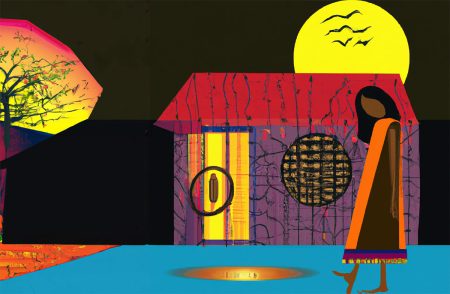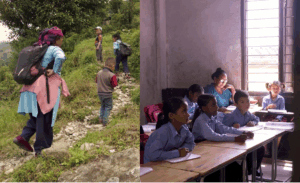If the momo is a living emblem of the evolving city, “momo aunties” like Tsering are those on whose shoulders the food stands.
Momo aunties are crucial participants in Delhi’s cityscape; they are to urban city dwellers a sign of solace, and a quick solution to hunger

A safe estimate is that momos first arrived in Delhi when the Dalai Lama fled Tibet, along with millions of Tibetans who looked to escape the Chinese annexation of their homeland. “Thousands followed him,” Tsering says, mentioning that her parents too were among those that walked to Indian borders, seeking refuge. Along with the refugees came momos. Recipes and plans for the Tibetan dish were set up in small stalls in Majnu Ka Tila and other smaller settlements where the refugees were rehabilitated. Until the 1980s, the momo remained fairly obscure, sold in some corners of the city, sometimes found in restaurants catering to refugees; it was still considered a foreign dish, bound by the neglect and ghettoisation of the people that brought it. While the exact moment when the momo stamped itself on the capital remains unknown, but that it holds behind it the lives of migrants from Tibet, Nepal and states like Sikkim in India’s Northeast is an undisputed fact.
In the late 1990s, the dish began to emerge in other ways, and integrated itself into Delhi’s urban geographies – immigrants from Nepal began arriving in Delhi for work; Bhutanese citizens of Nepali heritage, made refugees in their own country, also arrived in camps on the country’s borders. When India’s economy liberalised in 1991, it created the promise of more jobs in factories, and call centres. This led to the migration of citizens of the Northeastern states like Sikkim, who were often from Gorkha communities, and they sold the momo in small restaurants and stalls.

However, even as India’s liberal approach to migrants provided entry, most of them remained unattended, and deprived of basic tools for integration, basic shelter and economic rehabilitation. Migration to India continued in swathes, but a gap remained in employment, leading to a rise in informal occupations. Among these were food vendors, and thanks to Delhi’s insatiable appetite for street foods, small food businesses emerged as viable ways to forge livelihoods.
Like other dumplings, the momo has many fillings and many virtues. For customers, it is cheap, robust and satisfying. For momo sellers, the ingredients – flour, fillings, and steamers – are easily available in the North Indian market. “It is convenient — a plate can be eaten alone, shared, packed to go, and taken to a spot somewhere to eat,” says Prakash. That the momo exists outside the rigorous traditions of Indian cuisine is also what makes it appealing and democratic to city dwellers. Additionally, momo chutney, a blend of red chillies, tomatoes and salt is also a component to the dish’s popularity. “Momo chutneys are always extra hot, it has the kind of bravado that Delhi loves in its food,” Prakash adds. “It is also fun, outside the ordinary — which is important for successful street foods. Think about why we eat gol gappas!”
Tsering opened her momo business in 1994, equipped with a small broken red table and a hand-drawn sign and partnered by her sister-in-law. Born and raised in the Tibetan settlement in Bylakuppe, Karnataka, she remembers resenting Delhi’s heat, pace and alien language. “It was difficult. Some days I would feel so defeated that I would sit under the table and hide,” she says.
Tsering acts out how she would respond: “Momo hai, bhaiya,” she learned to say from a North Indian friend, and prod a potential customer to eat one. “I had to practice it like a mechanical drill, otherwise I would get emotional,” she adds.


Annu Thapa, a momo vendor in Taimur Nagar, echoes that momos have a place amidst business and routine. Thapa is the sole proprietor of Annu Aunty’s Veg Momos, a beloved spot in Taimur Nagar, located not far from universities like Jamia Millia Islamia. “The kids love my momos; they also come here because I set out places to sit, and I don’t fuss about payments.” she says. “They also like momos because they don’t get this at home, so it’s something different but also familiar,” she adds. Thapa lives in a one-bedroom apartment with her husband, with a view of the main road. In her balcony, she grows small mandarins, and a medicinal plant from her childhood home in Darjeeling.
Thapa was born the eldest of eight siblings, to a family of Gorkha migrants from Nepal. She was 15 years old in the 1990s when she arrived in Delhi, and after many years of work, started her momo stall in 2003. Thapa remembers the ’90s as a disorienting decade. “Suddenly, everyone said that we have to go to the city – that is where there will be a ‘better life’.” She remembers those like herself, who lived on the periphery of societies. But when she arrived, she was recruited as a domestic worker for a family that pelted her with physical and emotional abuse. “It was horrible. I returned home, I almost didn’t want to try again,” she says.
“It was the culture of the time that people wanted Gorkha women to work in their homes. And we had no opportunities, so we came.” As Thapa says, agencies and unregistered lobbyists brought thousands of young migrants to the cities, and then left them stranded without jobs.
She says, “Every day, you have to wake up and do the labour of preparing the momo for seven hours, and then sell for the rest of the day. There are no permits or allowances here for people like us: we spend from our own pocket. Everything that I make from my sales has to go towards the next day.” She also elaborates how the Covid-19 pandemic and the erratic lockdown that followed caused great damage to informal street vendors, especially women. A study showed that 97 per cent of women vendors had been adversely affected by the lockdown, leading to financial and psychological precarity. Today, the one-bedroom house she shares with her husband is subject to escalating rents. The landlord of her shop moved her to the back, lowering her clientele base, which already had decreased after the pandemic. Thapa dug into her savings for medical purposes, food and rent. She mentions that the pandemic also highlighted ethnic bigotry of mainland Indians.
“Some people called me names, like Chinese and Corona. I did not get these racial slurs even when I moved [here].” she said. “Some people tell me to ‘go back’. But go back where? I have worked here for 30 years and still I am supposed to be an outsider?”
In Mayur Vihar in East Delhi, Anita Rana tells a similar story. She started her stall in 2012, selling near the metro station. “I had a small business, but it was secure,” she says. She works on a smaller scale than both Thapa and Tsering, serving 60 plates of momos a day. “But once the metro closed down, my customers disappeared. “For seven months, I sat at home, spending from my savings. But now I am determined to try again.” she says. Rana is from Pokhara, Nepal, and arrived in Delhi as a teenager with her husband, also a complete stranger, in 2003. In 1950, India signed the labour pact that opened the borders for Nepalese labourers to enter the country with only their national IDs. According to the Asian Centre for Human Rights, from 1996, an estimated 350,000 to 400,000 Nepalis have been internally displaced from their villages, many of whom make their way into India.
Immigration from Nepal increased in 2001, with the armed civil conflict escalating in the country, especially its far west. India became a preferred destination because of its proximity and open border, cultural affinities, easily convertible currency, and the histories of migrations and communities set up by the Gorkhas recruited by the British army in the 19th Century. But even so, migrants from Nepal, especially women, remain deprived of rights and infrastructural assistance. Many women are trafficked into prostitution or unpaid domestic work. “I didn’t know where I was going. I was a teenager, married off, and then suddenly I was here. And it was dangerous, the kinds of places I could end up.” Rana says. Upon discovering that her husband was alcoholic, she got a job as a domestic worker in RWAs in Mayur Vihar. “But I was treated badly; people think Nepalis are cheap, so they are slaves. I decided I didn’t want to do that anymore. I have dignity, and even though I am a migrant, I deserve to build my life with the same.”
Today, Rana says that she has bought land in her village with the income from her momo stall. “Some people make momos to stay here, I do it to return,” she laughs.

In a country where women are expected to stay indoors by default, the spaces momo aunties have created are urban centres of recreation, democratic food joints, and where modernity, aspiration and youth culture all come to meet.
Today, even as companies like WOW Momo! invest in the low-key delicacy, it is on the laminated paper plates that impatient eaters and momo vendors, surrounded by their loyal customers, that the momo lives its best life. In Chirag Dilli, a small ‘momo village’, women and men from different communities make thousands of the dumplings in a day, shipping them across the city for sale. While the momo remains elevated in novelty, the lives it encompasses are of those that build a city.
In her shop, Tsering remembers how she felt doubtful of the same dish that had raised her. “I would think, this is something I love. Why do others hate it? This would make me feel bad,” she remembers. When asked whether she would consider serving other Tibetan dishes, she demurs.
“The momo is a bridge: it sits well with us, and with North Indians. We have to pay attention to who the customer is. See, I don’t want to put chaat masala and mayonnaise in the momo, but people demand it. What should I do? Authenticity, entrepreneurship, these are all big words for big people. My momo came from the need for survival; for now this is enough. My momo has helped me make a home here. I will keep it as it is.”





